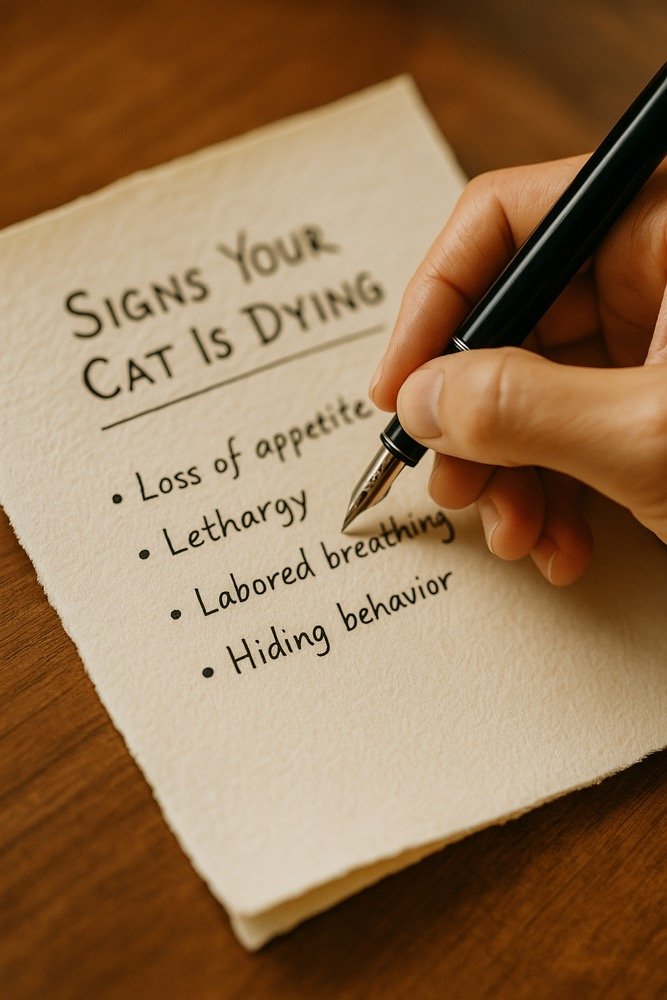Quick Takeaway: Recognizing the signs your cat is dying early can help you provide comfort and prepare emotionally.
Facing the final days of a cherished companion is heart-wrenching. Spotting the signs your cat is dying—from behavioral shifts to physical changes—allows you to act with compassion, ensure their comfort, and find gentle ways to cope. Below, we cover key indicators, practical tips, and memorial ideas to guide you through this tender time.

Recognizing Signs Your Cat Is Dying
Understanding common end-of-life markers helps you respond with empathy and care.
- Loss of appetite: Eating far less or refusing food entirely.
- Lethargy: Sleeping more than 20 hours a day, minimal interest in play.
- Labored breathing: Shallow or rapid breaths; possible wheezing.
- Weight loss & muscle wasting: Noticeable loss along the spine and hips.
- Hiding behavior: Seeking seclusion in quiet, dark spots.
Note: For medical guidance, consult your veterinarian or the American Veterinary Medical Association¹.

1. Offer Comfort with a Soft Space
Create a warm, accessible resting area to soothe stress and pain:
- Soft bedding: Use memory-foam pads or plush blankets.
- Easy access: Low-walled boxes or pet stairs to soft furniture.
- Consistent warmth: A mild heating pad (on low) under a blanket.
| Item | Benefit |
|---|---|
| Memory-foam pad | Relieves joint pressure |
| Fleece blanket | Provides cozy comfort |
| Heating pad (low) | Eases muscle stiffness |
2. Maintain Gentle Routines
Even simple rituals can calm anxiety and preserve connection:
- Quiet cuddle time: Sit beside them, speak softly, stroke fur.
- Hydration monitoring: Offer water or veterinary electrolyte solution.
- Toilet assistance: Keep litter box nearby; clean frequently.
Consistency reassures a dying cat that they remain loved and safe.
3. Manage Pain and Symptoms
Work closely with your vet to address discomfort:
- Pain medication: Follow prescribed doses for analgesia.
- Appetite stimulants: Use vet-approved supplements if needed.
- Breathing support: Humidifier in the room or gentle steam sessions.
Learn more: See PetMD’s hospice care tips² for at-home symptom management.
4. Prepare Emotionally with Mindful Practices
Coping with grief begins before loss:
- Journaling feelings helps process uncertainty.
- Short video clips capture playful, loving moments.
- Share stories with friends or support groups (e.g., ASPCA Support³).
Mindful reflection fosters acceptance and honors your bond.
5. Create a Lasting Tribute
Memorializing your cat can bring comfort and closure:
- Commission a handmade keepsake—like a custom felt portrait or clay figurine.
- Plant a memory garden with their name on a stone or plaque.
- Compile a photo album of favorite moments.
Explore personalized options at MY Kids Pet Keepsakes.

When to Seek Euthanasia
Deciding can feel overwhelming. Consult your vet if your cat:
- No longer recognizes you or shows distress.
- Suffers uncontrollable pain despite treatment.
- Can’t eat, drink, or move without agony.
Humane euthanasia under veterinary care can prevent needless suffering (American Humane)⁴.
Brand Soft CTA
Navigating the signs your cat is dying is never easy, but you don’t have to do it alone. At MY Kids, we craft heartfelt memorial gifts—like needle-felted portraits and clay sculptures—to honor your companion’s legacy. Email us at sales@mykidspetsupply.com or visit our shop homepage to learn how a handmade keepsake can bring comfort during this tender time.




